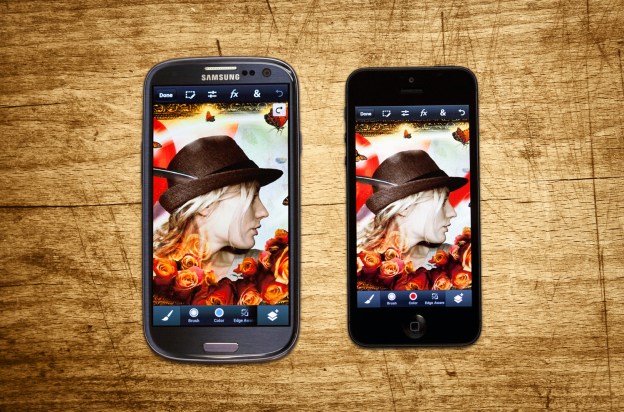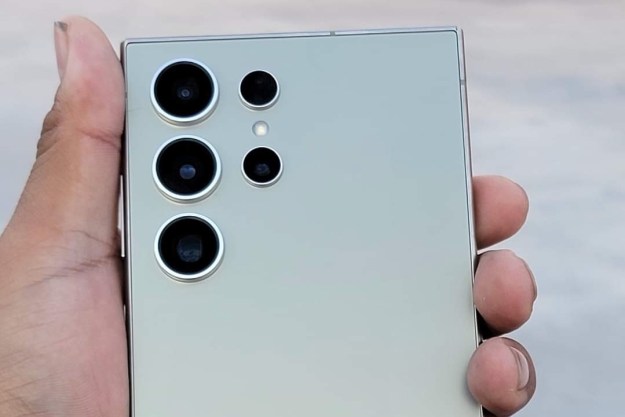
Samsung is trying to take the world by storm with its new Galaxy S4 smartphone, going so far as to unveil it at Radio City Music Hall with the backing of an orchestra and Broadway actors and singing. It’s been hard at work trying to convince people the “life companion” it’s launching in April is a must-have device. However, many of the S4 features flaunted at Samsung’s big unveiling are already, well, available to other phone owners. Honestly, if you download a few apps or buy the right phone, you can turn your own phone into a Galaxy S4 without much hassle.
Below are some apps and devices available that already have many of the innovations present in the S4. Don’t get us wrong, we love the Galaxy S4, but we never love the hefty price tag that comes with a brand new phone.
Translate speech from one language to another
S Translate seemed pretty nifty when Samsung showed it off last week, and even though you need an Internet connection for most features, it’s very intuitive in its ability to help you get directions or find your way around town in a country where people speak a foreign language. Then again, it’s nothing new either. Dozens of translators off of Google’s Play Store can do all the Galaxy S4 does, and more. Talk Translate for example handles 12 languages with voice recognition much like S Translate, and can translate and read back text between 30 languages, too. If you want translation of pictures and text, then consider Word Lens, which not only translates text, but also maintains the original font, and does it in real time through augmented reality. Word Lens, while amazing, only works with English and four other languages so far, but does work without an Internet connection. Either way, these apps are a great way to get a complete translation experience without needing the Galaxy S4. Google’s own Translate app works great, as well.
Dual Camera functionality is already on LG phones
Everyone is looking to steal glory away from Samsung’s big unveiling, and LG is already bragging about its phones and how they can do the dual-camera magic just like the Galaxy S4. The LG Optimus G Pro, already out and available for purchase in Korea, ships with dual-camera software that lets you take photos and make phone calls utilizing both the front and rear camera. The LG Optimus G will likely get the functionality at some point, as well. But the Optimus G Pro won’t be in the U.S. for a couple of months. If you can’t wait, you can also try DuoCam in the meantime. Duocam is an iOS app that allows you to feature front and rear camera images side by side, or even blend them into a unique photo to send to friends and family. There are tons of apps out like Multi-lens Camera that let you craft photos using multiple camera shots from both cameras, too.

Adding audio to your photos is old news
Including audio with a photo you take is far from innovative, and there are already apps out for both iOS and Android that can handle this with ease. StoryMark is able to take a photo, add audio, and turn it into a wonderful audio-image combination that can be then shared with anyone through email, Facebook, MMS, or even YouTube.
S Voice isn’t the only assistant out there
S Voice is Samsung’s own flavor of the personal assistant, but it’s not the only one available. It spawned from Apple’s Siri voice assistant app. S Voice is nice and all, but most people prefer Google Now for a number of reasons. Google Now is much faster than S Voice for answering questions and conducting searches, and integrates better with other Google apps. For example, it can easily send out mail via Gmail, and obtain directions with Google Maps. While there is no driving mode for Google Now (yet), it’s available with just a touch of the button from any Jelly Bean capable Android device (most high-end phones that have come out since summer 2012 have Google Now).

You do not need a GS4 to edit photos
The Samsung Galaxy S4 is said to feature a bunch of quick and easy ways to take photos and edit them on the fly, turn them into GIFs, make them into photo albums you can order, and so on. Then again, there are plenty of reasonable apps already on the market that can handle a number of photo editing tasks including those on the Galaxy S4. When it comes to making edits of any shape or size, look no further than Photoshop for phones, which offers a very intuitive and feature-rich way to edit photos, apply brushes, and even finish projects you start on your phone with the real Photoshop. To animate GIFs, GIF Camera is a quick and painless way to take videos and turn them into the popular and lively file-type. If you want any sort of filters or other typical editing options for your photos, there’s always Instagram and a host of other photo editors on the Play Store. While the Galaxy S4 is offering instant-edit opportunities, these apps pack a bigger punch, take a little longer to load, and save you the trouble of getting an entirely new phone to get the job done.

Gesture functionality isn’t unique
Gestures are pretty cool, and Samsung is going all-out with gestures on the Galaxy S4. Between adjusting brightness, tilting the screen, or stopping videos based on where your face is and what your fingers are doing, it’s certainly a very intuitive experience to use gestures. While some of these features are hardware based and difficult for other phones to come even close to mimicking, you can still use plenty of readily-available gesture apps to some of the gesture features the Galaxy S4 brags about. It requires a root, but Good Mood Droid (GMD) offers a ton of gesture plugins for Android devices, such as screen rotation based on face location, as well as others that depend on just a flick or twist of a finger. Plus, some applications like the Chrome browser already come with certain gesture-features built right into them. Chrome can scroll the page you’re reading with just a flick of the phone, offering similar gesture scrolling right inside your Web browser.
Or better yet, just wait it out with your Galaxy S3 or Note 2
While you can certainly buy the new Galaxy S4 in April with all of the new software features it brags about, you could also wait a few months and get a lot of the same features for free. Samsung has said it will bring many of these new software features to its other devices, including the Galaxy S3 and Galaxy Note 2, in future updates. So … you could save money and just buy a Galaxy S3. A lot of the features advertised with the Galaxy S4 are coming to other Galaxy devices in the future.
When you forget about the marginally bigger screen, better processor, and other such hardware changes, the Galaxy S4’s new features aren’t earth-shaking innovations. They’re features that many of the phones on sale today already have, or can have if you install a few choice apps. There are some features, such as the integrated infrared sensor, in the Galaxy S4 that others are incapable of, but even infrared functionality is becoming a common feature. Either way, the Galaxy S4 is still shaping up to be a wonderful new flagship for Samsung, but don’t let its new “life companion” philosophy tell you that everything featured in the Galaxy S4 is new and improved. Pick the phone that’s actually right for you.
Editors' Recommendations
- How to try Samsung’s Galaxy AI on any iPhone or Android phone
- Samsung Galaxy S24 Ultra vs. iPhone 15 Pro Max: Which one is best?
- I’m a lifelong iPhone user. Here’s what I think about the Samsung Galaxy S24
- Samsung Galaxy S24 vs. iPhone 15: don’t buy the wrong one
- I want the iPhone 16 to steal these 6 Galaxy S24 features


